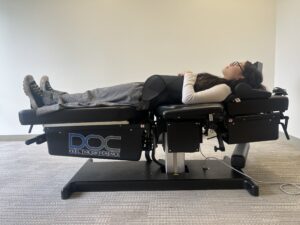Should you foam roll the low back?
The foam roller is an instrument used to increase mobility and improve your soft tissue quality. When it comes to the benefits of foam rolling, there is a big difference between the thoracic spine and the lumbar spine.
You should never foam roll your lower back (lumbar spine). I’m going to tell you exactly what to focus on instead if you are attempting to loosen up a stiff lower back.
Why Does Anatomy Matter?
Let’s begin by looking at the anatomy of the spine. There are three defined regions of the spine:
- the cervical curve (neck)
- the thoracic curve (mid back)
- the lumbar curve (low back)

The cervical spine is the upper 7 segments that are located in your neck. The thoracic spine is the middle 12 segments that make up the middle of your back. The lumbar spine is the final 5 vertebrae that make up the lower back. Most disc problems occur in either the cervical or lumbar spine.
If you look closely at the differences between the thoracic and lumbar spine there is one that should catch your eye. It is that the thoracic vertebra articulate with the ribs on the front side at each level. In contrast, the vertebra in the lumbar spine has no connection with the ribs. This means that the middle back is supported on the front by a stable rib cage. Uniquely, the lumbar spine is not and is much more unstable because of this.
If you are going to foam roll your upper back you get the added benefit of having the force dispersed to the nearby scapula or shoulder blades as well. In fact, you consciously have to raise your arms out over your body if you want to target and hit the spine most effectively during the foam rolling. But beyond this, there is another very important anatomical difference that accounts for rolling of the upper back and not rolling the lower back. That is the natural curvatures of those areas of the spine.

Your Spine Throws Curves
The thoracic spine is naturally curved forward into something called kyphosis. This is when you slump your shoulders forward and look hunched over. You may develop forward head posture the more you ignore your posture and develop muscle imbalances over time. We are all chronically deficient in thoracic extension. Using the foam roller to help you get more extension is one of the most valuable things you can do secondary to a thoracic chiropractic adjustment.
On the other hand, the curve of the lumbar spine is the opposite. It is naturally lordotic which means that it curves backward. Forcing your lower back into more extension is going to aggravate many conditions that are devastating if the extension gets worse. Conditions like stenosis or a spinal stress fracture are most notable. Even if neither of these conditions exists, you are never really able to effectively roll this area. This is because the muscles surrounding the lower back spasm to try and guard against the unprotected area. If you push through this tightness you are at a higher risk for putting pressure on your sciatic nerve.

Foam rolling benefits are plenty, however, it is best to look to other ways to address the stiffness and tightness you are feeling in your lower back. It’s important to know how to use foam rolling recovery techniques the right way. If foam rolling does not help you, it is good to look at corrective exercises for the muscles of the hips and glutes or possibly dry needling therapy.
To get to the root cause of pain and discomfort, schedule an initial consultation, including a comprehensive evaluation and first treatment.



